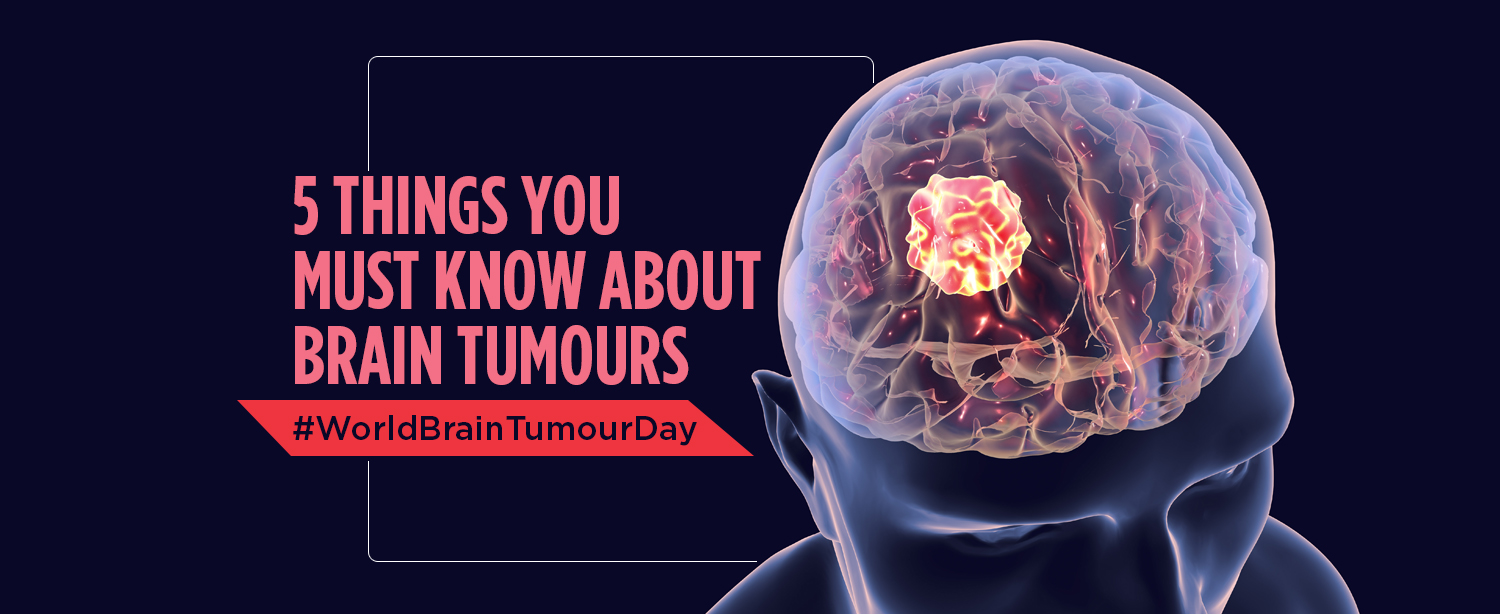There has been an increase in the incidence of brain tumours in India over the years. About 50,000 new cases are reported each year, out of which 20% occur in children. There are over 120 different types of brain and central nervous system tumours all showing different symptoms and requiring different treatment options. This #WorldBrainTumourDay let us understand and spread awareness about some important things about Brain tumours:
1. What is a Brain Tumour?
A brain tumour is a growth or mass of cells that has grown abnormally in or around your brain. The spinal tumours and brain tumours together are called central nervous system (CNS) tumours. Some tumours grow quickly, while others take their time to develop. Brain tumours, whether malignant or not, can have an influence on your health and brain function if they grow large enough to push on surrounding nerves, blood vessels, and tissue.
There are two general groups of brain tumours:
- Primary brain tumours start in the brain and tend to stay there.
- Secondary brain tumours are more common and start somewhere else in your body and travel to the brain. Lung, breast, colon and kidney, cancers are among the most common cancers that spread to your brain.
Grades of Brain Tumours
Tumours are graded by how normal or abnormal the cells look. The grading also gives you an idea of how fast the tumour may grow and spread and helps oncologists determine your treatment plan. The grades of tumours include:
- Grade 1.
These cells look nearly normal and grow slowly. Long-term survival is likely. - Grade 2.
These cells look slightly abnormal and grow slowly. The tumour may spread to nearby tissue and can come back, maybe at a more life-threatening grade. - Grade 3.
These cells look abnormal and are actively growing into nearby brain tissue. These tumours tend to come back. - Grade 4.
These cells look most abnormal and grow and spread quickly.
2. Malignant and benign brain tumors
Your doctor will conduct a thorough examination on your brain tumour to determine if it’s malignant or benign. This will help determine an appropriate treatment strategy. Some brain tumours are noncancerous (benign), while some brain tumours are cancerous (malignant). The term “malignant” refers to a tumour that is made up of cancer cells. These cells have the ability to infiltrate neighbouring tissues. Some cancer cells have the ability to travel via the circulation and lymph nodes. They can then spread to other organs and tissues in the body. The majority of dangerous tumours grow quickly, but the majority of benign tumours do not. There are, however, cases of both slow-growing malignant tumours and fast-growing noncancerous tumours. A benign tumour can grow to be fairly large, but it will not migrate to other parts of your body or invade neighbouring tissue.
3. Brain tumours in children
Paediatric brain tumours are abnormal cell masses or growths that develop in a child’s brain or nearby tissue and structures. The type of tumour, its location within the brain, whether it has spread, and your child’s age and overall health all influence treatment and prognosis. If your child is showing any signs of a brain tumour, you must get it investigated. Treatment for brain tumours in children is typically quite different from treatment for adult brain tumours, so it’s very important to enlist the expertise and experience of paediatric oncology specialists.
4. How early detection helps?
The ability to detect a brain tumour earlier, when it is smaller, reduces the impact of surgery and treatment, improving the prognosis for all patients. Some early tumours may have signs and symptoms that can be noticed, but this is not always the case. Do not ignore any unusual signs of symptoms such as persistent headaches, seizures, balance problems or vision changes.
5. Treatment options available
Your brain tumour treatment depends on the type of brain tumour you have, as well as its size and location. The standard treatment for brain tumour includes surgery, radiation therapy, and/or chemotherapy. Generally, radiation and chemotherapy treatments are used as secondary treatments for tumours. However, in rare cases, radiation and chemotherapy may be used without surgery if the tumour is inoperable.
Do you know someone suffering from this condition? Meet our dedicated team of neurosurgeons, medical oncologists, paediatric oncologists and radiation oncologist specialised in Neurooncolgy at Kokilaben Dhirubhai Ambani Hospital. Our Centre for Neurosciences is best equipped to treat brain tumours with great surgical expertise and advanced technologies. Our team also uses the latest operative advances with navigation, awake surgery techniques, neurophysiology monitoring with MEP and SSEP, radiosurgery and stereotactic radiotherapy.
The Department of Neurosciences is headed by Dr. Abhaya Kumar who has great expertise in treating Brain Tumours and conducting minimally invasive spine surgeries. He has successfully preformed over 2000 brain tumour surgeries in the past. He is one of the few neurosurgeons who is skilled in both brain and spine surgery. His success rate in treating brain tumours is 90%, with residual tumour in only 10% of patients. This is in line with international standards. He has also performed over 300 Awake Neurosurgery procedures. For further assistance on brain tumour care, please visit our below website link: https://www.kokilabenhospital.com/departments/centresofexcellence/centrefor_neurosciences/braintumor.html


